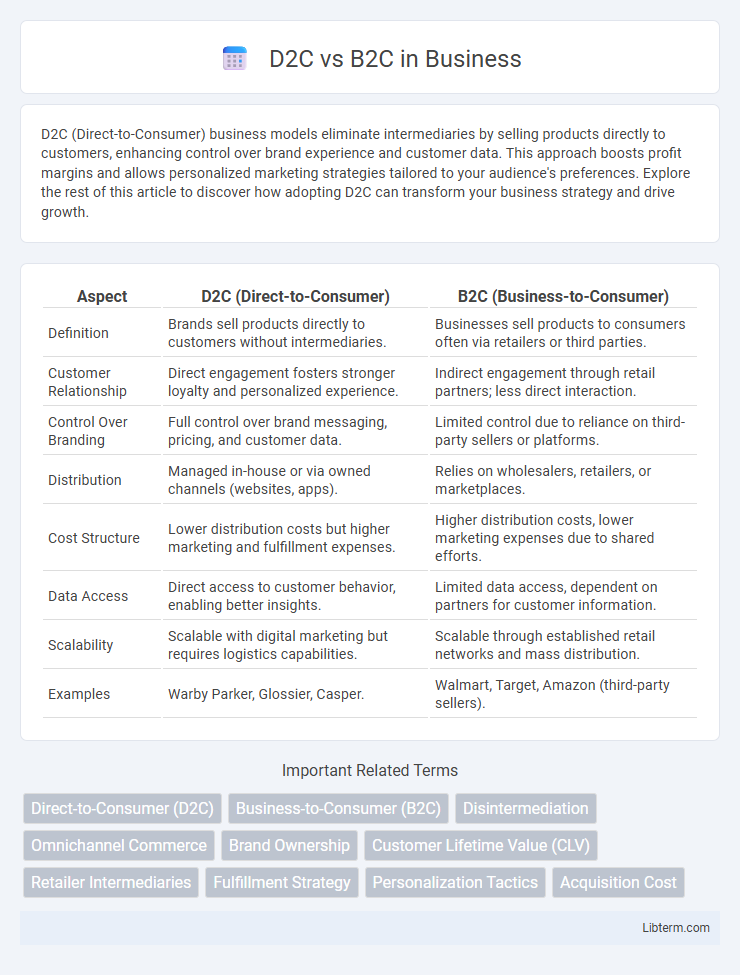D2C (Direct-to-Consumer) business models eliminate intermediaries by selling products directly to customers, enhancing control over brand experience and customer data. This approach boosts profit margins and allows personalized marketing strategies tailored to your audience's preferences. Explore the rest of this article to discover how adopting D2C can transform your business strategy and drive growth.
Table of Comparison
| Aspect | D2C (Direct-to-Consumer) | B2C (Business-to-Consumer) |
|---|---|---|
| Definition | Brands sell products directly to customers without intermediaries. | Businesses sell products to consumers often via retailers or third parties. |
| Customer Relationship | Direct engagement fosters stronger loyalty and personalized experience. | Indirect engagement through retail partners; less direct interaction. |
| Control Over Branding | Full control over brand messaging, pricing, and customer data. | Limited control due to reliance on third-party sellers or platforms. |
| Distribution | Managed in-house or via owned channels (websites, apps). | Relies on wholesalers, retailers, or marketplaces. |
| Cost Structure | Lower distribution costs but higher marketing and fulfillment expenses. | Higher distribution costs, lower marketing expenses due to shared efforts. |
| Data Access | Direct access to customer behavior, enabling better insights. | Limited data access, dependent on partners for customer information. |
| Scalability | Scalable with digital marketing but requires logistics capabilities. | Scalable through established retail networks and mass distribution. |
| Examples | Warby Parker, Glossier, Casper. | Walmart, Target, Amazon (third-party sellers). |
Understanding D2C and B2C: Key Definitions
D2C (Direct-to-Consumer) refers to brands selling products directly to customers, bypassing traditional retail channels to enhance customer relationships and control over brand experience. B2C (Business-to-Consumer) involves businesses selling goods or services to end-users through intermediaries like retailers or online marketplaces. Understanding these models helps businesses optimize marketing strategies, streamline distribution, and improve customer engagement by choosing the most effective sales approach.
Market Dynamics: D2C vs B2C
D2C (Direct-to-Consumer) leverages digital platforms to eliminate intermediaries, enabling brands to gather firsthand customer data and rapidly adapt to market trends. B2C (Business-to-Consumer) channels often rely on established retail partnerships, resulting in broader reach but less control over customer experience and data insights. Market dynamics in D2C emphasize personalized marketing and agile supply chains, while B2C focuses on scale and distribution through physical and online retailers.
Customer Relationships in D2C and B2C Models
D2C (Direct-to-Consumer) models foster closer customer relationships by enabling brands to collect first-party data and deliver personalized experiences without intermediaries. B2C (Business-to-Consumer) models often involve retailers or marketplaces, which can dilute direct interaction and customer insights. Strong customer engagement in D2C drives loyalty and higher lifetime value through tailored marketing and direct feedback loops.
Marketing Strategies: D2C Against B2C
D2C marketing strategies emphasize direct consumer engagement through personalized content, social media influence, and data-driven campaigns that optimize customer acquisition and retention without intermediaries. In contrast, B2C marketing often relies on broad-reaching tactics such as mass media advertising, retailer partnerships, and pricing promotions to influence consumer behavior across distribution channels. D2C brands leverage first-party data to create tailored experiences, enhancing brand loyalty and lifetime value, while B2C brands focus on market penetration and extensive reach through third-party platforms.
Supply Chain Differences: D2C Compared to B2C
D2C supply chains bypass traditional retail intermediaries, enabling direct manufacturer-to-consumer fulfillment that reduces lead times and inventory costs. B2C supply chains typically involve multiple layers, including wholesalers and retailers, which can introduce delays and increase handling complexity. D2C models emphasize streamlined logistics, direct shipping, and enhanced customer data integration to optimize order accuracy and personalization.
Technology and E-commerce Platforms
D2C (Direct-to-Consumer) businesses leverage advanced e-commerce platforms such as Shopify, BigCommerce, and WooCommerce to deliver personalized shopping experiences and gain direct customer insights, bypassing traditional retail intermediaries. B2C (Business-to-Consumer) models utilize large-scale marketplaces like Amazon and eBay, relying heavily on extensive product listings, customer reviews, and third-party logistics integrations to reach mass audiences. Technology innovations including AI-driven recommendation engines, integrated payment gateways, and real-time data analytics play crucial roles in optimizing both D2C and B2C e-commerce strategies for enhanced customer engagement and operational efficiency.
Brand Control and Customer Data Ownership
Direct-to-Consumer (D2C) models provide brands with full control over their product presentation, pricing, and marketing strategies, enabling a consistent and tailored customer experience. In contrast, Business-to-Consumer (B2C) models often rely on intermediaries, reducing brand control and diluting messaging. D2C companies also capture comprehensive customer data directly, facilitating personalized marketing and deeper consumer insights, whereas B2C ecosystems typically restrict data access or share limited information due to third-party involvement.
Pricing and Profit Margins: D2C vs B2C
D2C brands typically achieve higher profit margins by eliminating intermediaries and selling products directly to consumers, allowing greater control over pricing strategies. B2C models often involve wholesalers and retailers who add markups, reducing the manufacturer's profit margin and limiting pricing flexibility. As a result, D2C companies can offer competitive prices while maintaining profitability, whereas B2C pricing relies heavily on retailer negotiations and market conditions.
Challenges and Opportunities in Each Model
D2C (Direct-to-Consumer) models face challenges such as building brand trust without intermediaries and managing logistics and customer service directly, but they offer opportunities for deeper customer insights and higher profit margins by eliminating middlemen. B2C (Business-to-Consumer) models benefit from established retail partnerships and broader market reach but encounter obstacles like dependency on third-party platforms, higher competition, and reduced control over customer data. Both models require strategic investments in digital marketing and customer experience to capitalize on evolving consumer behaviors and technological advancements.
Choosing the Right Model: D2C or B2C?
Choosing the right model between D2C (Direct-to-Consumer) and B2C (Business-to-Consumer) depends on factors such as control over branding, customer data ownership, and distribution channels. D2C offers enhanced customer relationships and higher profit margins by eliminating intermediaries, while B2C benefits from established retail partnerships and broader market reach. Evaluating product type, target audience, and marketing capabilities is crucial for selecting the most effective model for sustainable growth.
D2C Infographic

 libterm.com
libterm.com